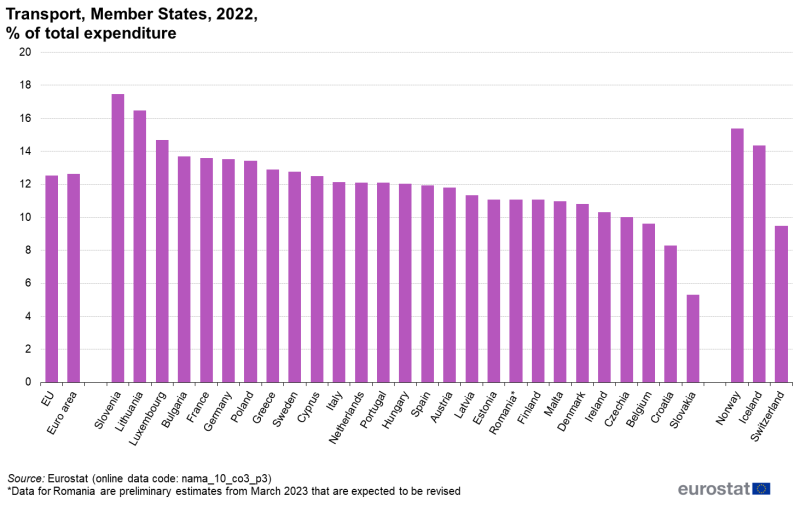Household consumption by purpose
Data extracted: 10 November 2023.
Planned article update: November 2024.
Highlights
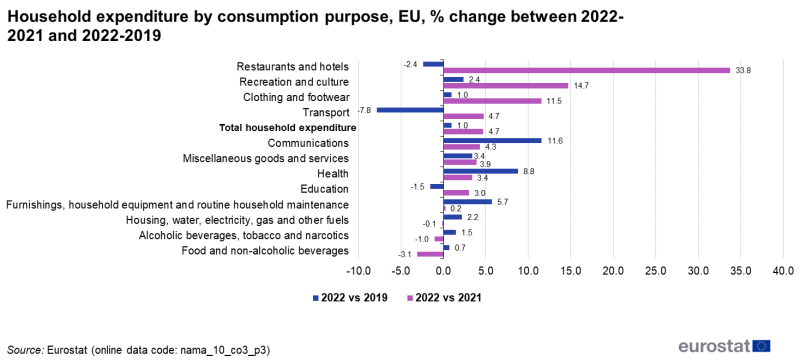
Source: Eurostat (nama_10_co3_p3)
This article analyses trends in the structure of household final consumption expenditure by consumption purpose (COICOP) which can be expected to have a significant influence on citizens' wellbeing.
Full article
Recovery from COVID-19 pandemic in 2022
The outbreak of the COVID-19 pandemic in Europe had severe economic impacts that are reflected in national accounts estimates for 2020 and 2021. There was a significant effect on both the overall level and the structure of household consumption, but in 2022 almost every category returned to or exceeded pre-pandemic levels. By showing the comparison with 2019, this section presents the recovery from the COVID-19 pandemic for the year 2022 for European aggregates and for countries. The comparison with 2021 is shown as well.
Developments by COICOP categories
To illustrate the recovery from the COVID-19 pandemic, Figure 1 shows changes in expenditure by category in 2022 compared with both 2021 and 2019. Compared with 2021, household consumption expenditure increased by 4.7 % in volumes in the EU. For the specific categories, the largest increases can be seen for 'Restaurants and hotels' (+33.8 %), which were heavily impacted by the COVID restrictions and closures and almost reached pre-pandemic levels in 2022. 'Recreation and culture' (+14.7 %), 'Clothing and footwear' (+11.5 %) and 'Transport' (+4.7 %) are also increasing.
Compared with 2019, the largest increase in 2022 is observed for 'Communications' (+11.6 %), followed by 'Health (+8.8 %) and 'Furnishings, household equipment and routine household maintenance' (+5.7 %). However, certain categories still lagged behind pre-COVID figures. Specifically, in 2022, household consumption was still below 2019 volumes for 'Transport' (-7.8 %), 'Restaurants and hotels' (-2.4 %), and 'Education' (-1.5 %).

Source: Eurostat (nama_10_co3_p3)
Developments by country
Almost all EU Member States recorded increases in household consumption in the year 2022 compared with 2021. The highest increases in household consumption were recorded in Malta (+18.9 %), followed by Cyprus (+11.8 %) and Croatia (+11.1 %). Czechia was the only country registering a slight decrease (-0.1 %) in 2022 compared to the previous year.
Compared with 2019, only five EU Member States, Czechia (-6.0 %), Spain (-1.5 %), Germany (-1.0 %), Italy (-0.8 %) and Austria (-0.7 %), exhibited lower volumes of household consumption expenditure in 2022. The largest increases in 2022 compared with 2019 were observed for Croatia (+13.7 %), Romania (+9.9 %) [1], Bulgaria and Estonia (both +8.9 %).
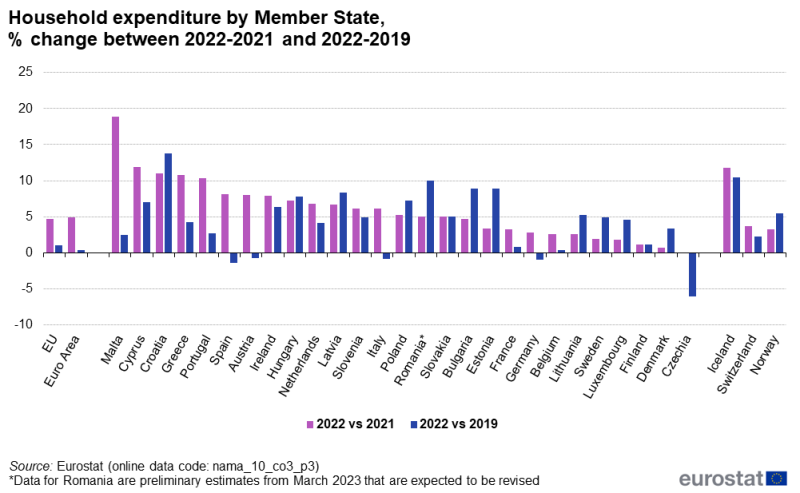
Source: Eurostat (nama_10_co3_p3)
Composition of EU household expenditure in 2022
Looking at the composition of EU household expenditure by consumption purpose and by the main 12 COICOP categories based on current price figures (see Figure 3, Table 1 and Table 2), almost a quarter of EU household expenditure (24.1 % of total or 12.4 % of GDP) was devoted to 'Housing, water, electricity, gas and other fuels'. Other large shares are observed for 'Food and non-alcoholic beverages' (13.6 % of the total or 7.0 % of GDP), 'Transport' (12.5 % of the total or 6.4 % of GDP), and 'Miscellaneous goods and services' (11.3 % of the total or 5.8 % of GDP). 'Housing, water, electricity, gas and other fuels', 'Food and non-alcoholic beverages' and 'Transport' account for half of the total household expenditure (50.2 %), with the composition remaining stable compared with 2021.
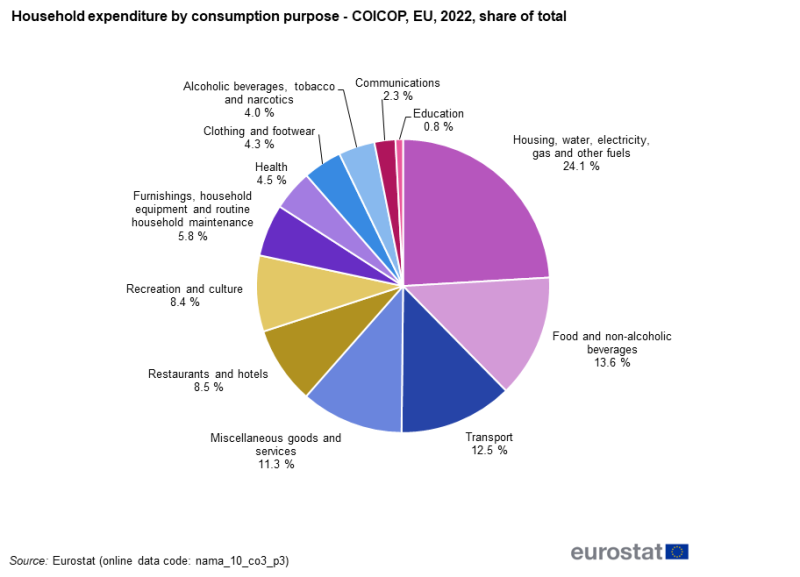
Source: Eurostat (nama_10_co3_p3)
'Restaurants and hotels' (8.5 % of the total or 4.4 % of GDP), 'Recreation and culture' (8.4 % of the total or 4.3 % of GDP) and 'Furnishings, household equipment and routine household maintenance' (5.8 % of the total or 3.0 % of GDP) followed. The remaining household spending was distributed over 'Health' (4.5 % of the total or 2.3 % of GDP), 'Clothing and footwear' (4.3 % of the total or 2.2 % of GDP), 'Alcoholic beverages, tobacco and narcotics' (4.0 % of the total or 2.1 % of GDP), 'Communications' (2.3 % of the total or 1.2 % of GDP) and 'Education' (0.8 % of
the total or 0.4 % of GDP, which together represented 15.9 % of total household expenditure or 8.2 % of EU GDP in 2022.
Analysis of EU aggregates
In 2022, EU total household expenditure amounted to 51.5 % of GDP, registering a slight increase compared with 2021 (49.8 % of GDP) and reaching almost the same share registered in 2019, when it amounted to 52.4 % of GDP. An overall downward trend has been observed since 2012, when household expenditure was at 54.9 % of GDP.

Source: Eurostat (nama_10_co3_p3)

Source: Eurostat (nama_10_co3_p3)
Composition in 2022 compared with 2019
Comparing the composition in 2022 with 2019, the largest decreases of shares were recorded for 'Transport' (-0.7 pp), followed by 'Clothing and footwear' and 'Recreation and culture' (both -0.3 pp). The largest increases in shares between 2019 and 2022 were recorded for 'Housing, water, electricity, gas and other fuels' (+0.6 pp), 'Food and non-alcoholic beverages' (+0.5 pp) and 'Furnishings and household equipment' (+0.2 pp).
Evolution of volumes compared with 2019
The analysis of household consumption in terms of volumes allows also for some interesting insights: the development of volumes (total) during the period 2010-2022 shows a gradual increase, with a few exceptions, over the whole period up to 2020, where we can see the impact of the COVID-19 pandemic. Starting from 2021, the effect of the recovery can be observed, along with the positive trend that continues in 2022, with important increases registered in both years for 'Restaurants and hotels', 'Recreation and culture', 'Clothing and footwear' and 'Health’. Despite the strong growth in 2021 and 2022, three categories, 'Transport', 'Restaurants and hotels' and 'Education' lag behind pre-pandemic levels.
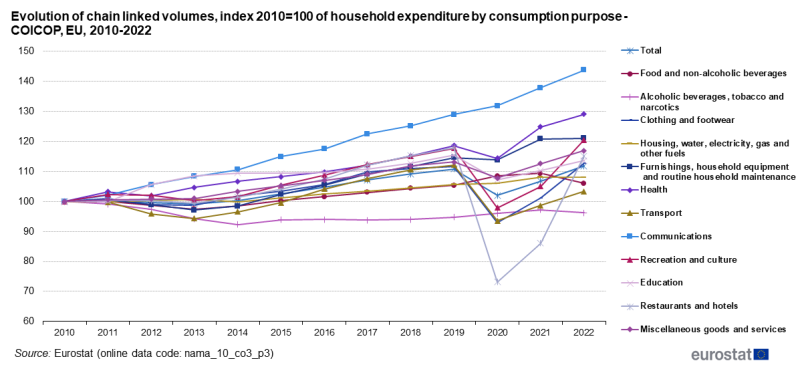
Source: Eurostat (nama_10_co3_p3)
Evolution of implicit deflator
Finally, some trends in the implicit deflator [2] seem worth mentioning: the development of implicit prices (of total) during the period 2010-2022 shows a steady increase. Compared to 2010, the largest increases were recorded in 'Alcoholic beverages, tobacco and narcotics' (+37.0 %), 'Food and non-alcoholic beverages' (+33.4 %), ‘Restaurants and Hotels’ (+29.7 %), ‘Transport’ (+29.5 %) and 'Housing, water, electricity, gas and other fuels' (+28.1 %); decreases were noted in 'Communications' (-25.1 %).
When comparing with 2021, the largest increases were registered for 'Transport' (+11.5 %), 'Food and non-alcoholic beverages' (+11.2 %) and 'Housing, water, electricity, gas and other fuels' (+8.4 %), while a decrease was registered for 'Communications' (-0.4 %).
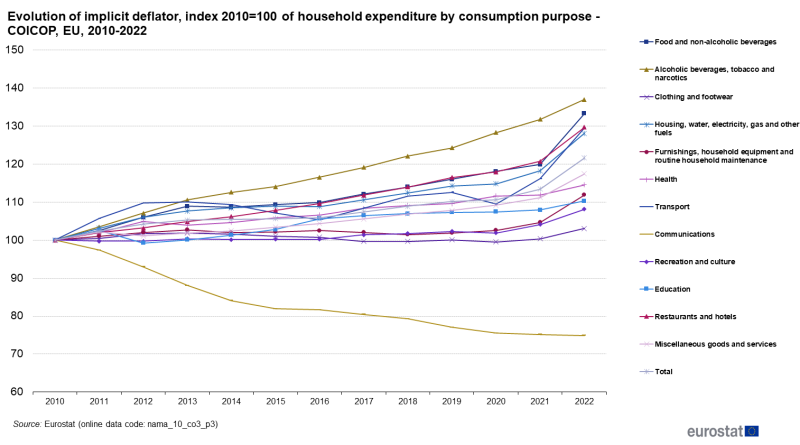
Source: Eurostat (nama_10_co3_p3)
Country specific trends
Household expenditure shares in 2022 still the highest in Greece and Croatia
Looking at the situation by country, the analysis can also point out some interesting trends: as a ratio to GDP in 2022, the highest shares of household expenditure were found in Croatia (75.3 %), Greece(74.6 %) and Portugal (68.8 %). The lowest shares were recorded in Ireland (23.9 %), Luxembourg (32.2 %) and the Netherlands (42.2 %).
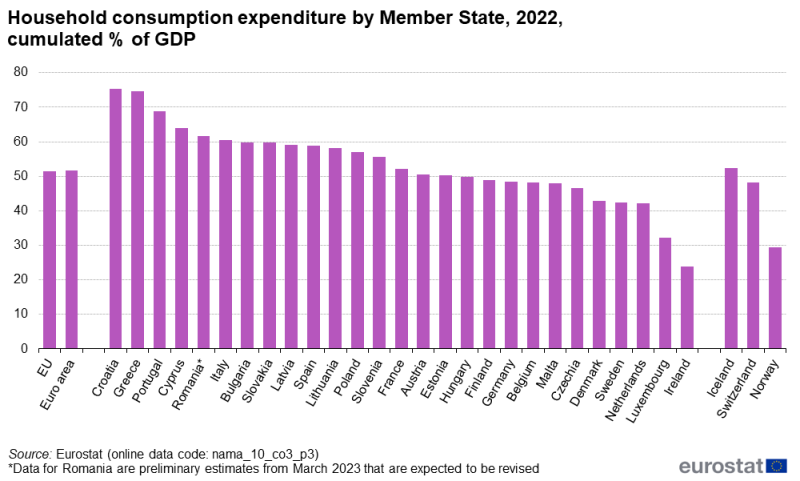
Source: Eurostat (nama_10_co3_p3)
In the EU as a whole, as well as in nearly all EU Member States, 'Housing, water, electricity, gas and other fuels' was still the most significant item of household expenditure in 2022, followed by 'Food and non-alcoholic beverages' and 'Transport'.
As regards expenditure on 'Housing, water, electricity, gas and other fuels', the highest shares in household expenditure can be observed in Slovakia (30.3 %), Finland (29.7 %) and Denmark (29.1 %). The lowest shares were registered in Malta (14.1 %), Croatia (14.9 %) and Lithuania (16.4 %).
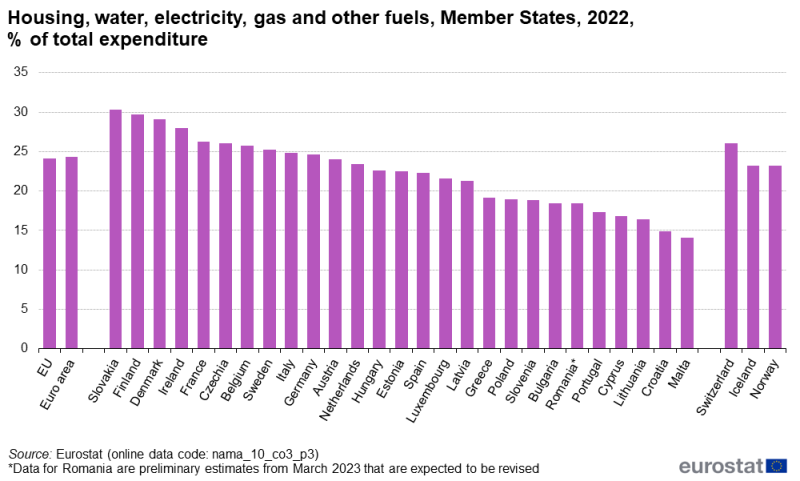
Source: Eurostat (nama_10_co3_p3)
For expenditure on 'Food and non-alcoholic beverages', the highest shares were recorded in Romania (25.0 %) [3], Bulgaria (20.8 %) and Latvia (19.7 %). The lowest shares were observed in Ireland (8.0 %), Luxembourg (9.3 %) and Austria (10.0 %).
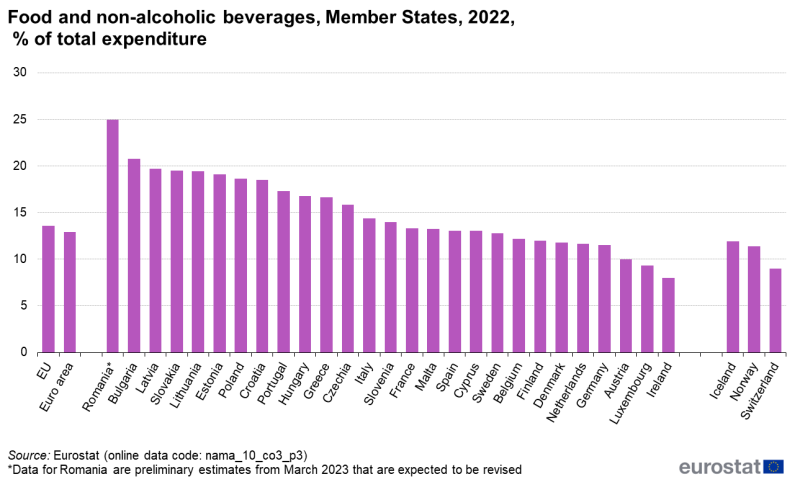
Source: Eurostat (nama_10_co3_p3)
Concerning expenditure on 'Transport', the highest shares in household expenditure were noted in Slovenia (17.5 %), Lithuania (16.5 %) and Luxembourg (14.7 %), while the lowest shares were found in Slovakia (5.3 %), Croatia (8.3 %) and Belgium (9.6 %).
Source data for tables and graphs
Data sources
Eurostat collects data on household final consumption expenditure according to the international Classification of individual consumption by purpose (COICOP) in the framework of ESA2010.
The transmission requirements for each dataset are defined in ESA 2010 transmission programme. For COICOP data these are T+9 months after the reference period. Therefore, in this article the latest data available refer to the year 2022.
Breakdowns
Household consumption expenditure is classified by consumption purpose according to the COICOP classification (Classification Of Individual Consumption by Purpose, see also Commission Regulation (EC) No 113/2002 of 23 January 2002). COICOP categories at three-digit level are as follows:
P01 - Food and non-alcoholic beverages
- P011 - Food
- P012 - Non-alcoholic beverages
P02 - Alcoholic beverages, tobacco and narcotics
- P021 - Alcoholic beverages
- P022 - Tobacco
- P023 - Narcotics
P03 - Clothing and footwear
- P031 - Clothing
- P032 - Footwear
P04 - Housing, water, electricity, gas and other fuels
- P041 - Actual rentals for housing
- P042 - Imputed rentals for housing
- P043 - Maintenance and repair of the dwelling
- P044 - Water supply and miscellaneous services relating to the dwelling
- P045 - Electricity, gas and other fuels
P05 - Furnishings, household equipment and routine household maintenance
- P051 - Furniture and furnishings, carpets and other floor coverings
- P052 - Household textiles
- P053 - Household appliances
- P054 - Glassware, tableware and household utensils
- P055 - Tools and equipment for house and garden
- P056 - Goods and services for routine household maintenance
P06 - Health
- P061 - Medical products, appliances and equipment
- P062 - Outpatient services
- P063 - Hospital services
P07 - Transport
- P071 - Purchase of vehicles
- P072 - Operation of personal transport equipment
- P073 - Transport services
P08 - Communication
- P081 - Postal services
- P082 - Telephone and telefax equipment
- P083 - Telephone and telefax services
P09 - Recreation and culture
- P091 - Audio-visual, photographic and information processing equipment
- P092 - Other major durables for recreation and culture
- P093 - Other recreational items and equipment, gardens and pets
- P094 - Recreational and cultural services
- P095 - Newspapers, books and stationery
- P096 - Package holidays
P10 - Education
- P101 - Pre-primary and primary education
- P102 - Secondary education
- P103 - Post-secondary non-tertiary education
- P104 - Tertiary education
- P105 - Education not definable by level
P11 - Restaurants and hotels
- P111 - Catering services
- P112 - Accommodation services
P12 - Miscellaneous goods and services
- P121 - Personal care
- P122 - Prostitution
- P123 - Personal effects n.e.c.
- P124 - Social protection
- P125 - Insurance
- P126 - Financial services n.e.c.
- P127 - Other services n.e.c.
Context
Consumption expenditure is what people, acting either individually or collectively, spend on goods and services to satisfy their needs and wants. A household’s economic well-being can be expressed in terms of its access to goods and services. The more that can be consumed, the higher the level of economic well-being, though the relationship between the two is not a linear one. Measuring consumption expenditure might, therefore, be a way of measuring economic well-being.
Studies of consumption investigate how and why society and individuals consume goods and services, and how this affects society and human relationships. Contemporary studies focus on meanings of goods and the role of consumption in identity making. Traditionally, consumption was seen as rather unimportant compared with production, and the political and economic issues surrounding it. However, with the development of a consumer society, increasing consumer power in the market place, the growth in marketing, advertising, sophisticated consumers, ethical consumption etc., it is recognised as central to modern life.
In national accounts, the final consumption expenditure of households is the biggest component of the expenditure approach to GDP. Its evolution allows an assessment of purchases made by households, reflecting changes in wages and other incomes, but also in employment and in savings behaviour.
Direct access to
- Annual national accounts (t_nama)
- National accounts detailed breakdowns (by industry, by product, by consumption purpose) (t_nama_brk)
- Final consumption expenditure of households by consumption purpose (COICOP) (t_nama_co)
- Household expenditure per inhabitant, by category (tsdpc520)
- Final consumption expenditure of households by consumption purpose (COICOP) (t_nama_co)
- National accounts detailed breakdowns (by industry, by product, by consumption purpose) (t_nama_brk)
- Mean consumption expenditure of private households (hbs_exp)
- Structure of mean consumption expenditure (hbs_struc)
- National accounts (na), see:
- Annual national accounts (nama),
- National Accounts detailed breakdowns (by industry, by product, by consumption purpose) (nama_brk)
- Final consumption expenditure of households by consumption purpose (COICOP) (nama_co)
- Final consumption expenditure of households by consumption purpose - COICOP 3 digit - aggregates at current prices (nama_co3_c)
- Final consumption expenditure of households by consumption purpose - COICOP 3 digit - volumes (nama_co3_k)
- Final consumption expenditure of households by consumption purpose - COICOP 3 digit - price indices (nama_co3_p)
- Final consumption expenditure of households by consumption purpose (COICOP) (nama_co)
- National Accounts detailed breakdowns (by industry, by product, by consumption purpose) (nama_brk)
- Prices (prc), see:
- Harmonised indices of consumer prices (HICP) (prc_hicp)
- HICP - Item weights (prc_hicp_inw)
- Essential SNA — Building the basics — 2014 edition
- European system of accounts — ESA 2010
- European system of accounts — ESA 2010 — Transmission programme of data (multilingual)
- Handbook on price and volume measures in national accounts
- Manual on the changes between ESA 95 and ESA 2010 — 2014 edition
- Regulation (EC) No 113/2002 of 23 January 2002 on Classification of expenditure according to purpose
- Regulation (EU) No 549/2013 (ESA 2010 Regulation) of 21 May 2013 on the European system of national and regional accounts in the European Union
- Implementing Decision (EU No 403/2014) of 26 June 2014 on granting derogations to Member States
- Annual national accounts (ESMS metadata file — nama_esms)
- Consumption expenditure of private households (ESMS metadata file — hbs_esms)
- Harmonised indices of consumer prices (HICP) (ESMS metadata file — prc_hicp_esms)
- Household expenditure by category, European Union, 2021 (as % of total expenditure)
Notes
- ↑ Data for Romania are preliminary estimates from March 2023 that are expected to be revised.
- ↑ Implicit deflator series are derived as a ratio of current price to chain-linked volumes series and give indication of underlying price changes.
- ↑ Data for Romania are preliminary estimates from March 2023 that are expected to be revised.
